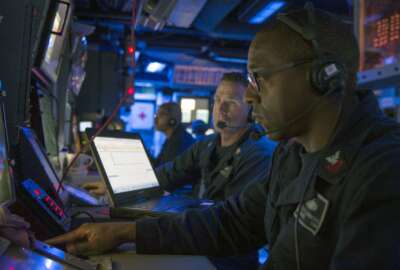Navy putting AI into practice through low-risk, high-reward uses
The Navy is putting artificial intelligence into practice through low-risk, but high-reward test cases.
The Navy is putting artificial intelligence into practice through low-risk, but high-reward test cases.
That includes the launch of its first conversational AI program, called Amelia, to answer thousands of help-desk requests in less than a minute. That frees up its IT personnel to handle more pressing matters.
Nathan Hagan, deputy data officer at the Office of the Chief of Naval Operations, said Amelia allows the Navy to answer thousands of help desk tickets in under 45 seconds, with only about 15 employees staffing the help desk.
“The value of that, is it allows us to perform a really important business function, keep it at a manageable scale, and then invest those resources that are saved, as a result of that … do something that is more pressing to the Chief of Naval Operations’ needs. In almost all cases, when I say something more pressing, I mean saving lives, shooting a weapon, to have an impact in the battlespace so that our sailors are safe,” Hagan said Oct. 13 during a recent Federal News Network-moderated panel discussion at AFCEA NOVA’s Navy IT Day event.
Amelia is a conversational AI, and uses natural language processing to understand the words that are being said. But Amelia doesn’t rely on training data beyond the Navy.
“Amelia only knows what it’s told to know … It’s a safe use case that we can leverage across the Navy,” Hagan said.
Duncan McCaskill, acting chief data officer for the Department of the Navy, said the department is also prioritizing steps to make its data a strategic asset.
“The challenge that we have is trying to identify what is of the highest value. And for that, we need to be talking to those mission and business elements that have those use cases. And then, being able to aggregate across all those use cases and understand this particular piece of data is going to be very high value … That’s something that we need to modernize to be able to get data out at speed at scale,” McCaskill said.
Hagan said the Navy faces a clear goal to have all its data characterized and cataloged by the end of fiscal 2026.
“We know that’s our target … Our thesis is that if we provide data in an organized fashion, that is well governed and made accessible, the algorithms, from an AI perspective, that are really tied to use cases, will then be able to tap into that well-structured data governance model, and pull the data they need to train appropriately and then move forward,” Hagan said.
The department is looking at AI as a tool to potentially accelerate the tagging and sorting of its data.
McCaskill said making full use of the data the Department of the Navy already has is critical to maintaining an information advantage against adversaries.
“That legacy data is really, really, really important. And if we don’t think that all of our adversaries are going back and looking through everything that they have over decades, all the things that they have on us, we should be doing those types of things for ourselves –looking back at all the data that we have, being able to go back and mark it at speed and at scale, understand what those data objects are, is critically important,” McCaskill said.
Copyright © 2025 Federal News Network. All rights reserved. This website is not intended for users located within the European Economic Area.
Jory Heckman is a reporter at Federal News Network covering U.S. Postal Service, IRS, big data and technology issues.
Follow @jheckmanWFED





